An international study of language learning at university in the 21st century: elements of synthesis

The project in question was led by SOAS colleague Prof. Anne Pauwels and entitled 'Language learning and attitudes in the 21st century'. It brought together an international team of researchers from the UK (SOAS & Warwick University), Germany (Humboldt Universität, Berlin), Lithuania (Vilnius University), Ireland (Trinity College Dublin), the Netherlands (Fryske Akademy), Singapore (Nanyang Technological University), France (Inalco) and the USA (University of Maryland and Bryn Mawr College).
The aim was, by drawing up a portrait of language learner profiles in higher education in these nine countries, to understand the new forms of multilingualism developing at university, the evolution of sociolinguistic attitudes towards the experience of plurilingualism and its place in a globalized educational system - particularly post-secondary.
The methodological approach consisted of a dual approach successively quantitative (questionnaire) then qualitative (semi-directed interviews). The first stage took place at the end of 2017, when the questionnaire was sent out to university student communities in six of the nine aforementioned countries. This 37-item questionnaire was administered via an electronic platform, and in line with the second stage of the research, interviews were conducted in the wake during 2018. Various changes in the teams and the arrival of the covid-19 pandemic made the exploitation and dissemination of the results more complex, but the teams are still working on it. One of the remarkable aspects of this project is that Inalco had the highest number of survey participants of all the participating universities, with some 1,877 questionnaires returned. The other partners recorded 583 responses (NTU, Singapore), 577 responses (University of Vilnius), 547 responses (Humboldt University, Berlin), 429 responses (SOAS London) and 102 responses (Trinity College Dublin, Ireland).
The limits of this text dictate that the following paragraphs merely present a few highlights from this study, which offers a recent linguistic portrait of our student community, and to some extent allows comparison with others elsewhere in the world. More comprehensive and targeted results are currently being published in scientific journals. What follows focuses on the results obtained at Inalco, with however some comparative openings proposed at the end of the article.
1. Participants at Inalco: a multilingual landscape
The majority of respondents at Inalco were women (73%, versus 22% men, and 4.5% non-responses), which is slightly higher than the general feminization rate of Inalco's student population (68% in 2017-2018, according to Planète Étudiante 2018). Behind the 87% of female responses in the Lithuanian questionnaire, this is the highest rate of female respondents in the entire survey. In comparison, the female response rate was 62% in the German questionnaire, 66% in the Singaporean questionnaire, 69% in the Irish questionnaire and 70% in the British questionnaire.
It's worth noting that respondents to the French questionnaire were overwhelmingly multilingual, with 83% indicating knowledge of more than 3 languages. By comparison, Lithuanian respondents gave the same answer at 86%, while 76% of German students, 71% of British students and 66% of Singaporean students indicated proficiency in more than 3 languages. The average age of French respondents was 28, with the youngest respondent aged 16 and the oldest 83, almost perfectly reflecting the institution's statistics in the same year (Planète étudiante 2018). The French sample has the highest average age of all six participating countries (where averages range from 22 to 25). At the time the questionnaire was distributed, 61% of respondents were undergraduates, including 31% in their first year and 31% in their 2nd and 3rd years. 26% were in master's or doctoral studies.
2. Language practice profiles
2.1. Language 1
When asked what they considered to be their mother tongue(s) - the question rather suggested looking at the first language learned, or Language 1 - a large majority (79%) considered themselves to be speakers of French Language 1. The number of declared Arabic speakers was 1.9%, while 1.8% of Turkish speakers, 1.6% of Italian speakers, 1.6% of Russian speakers, 1.5% of Chinese speakers and 1.3% of English speakers took part in the survey. These figures remind us that 20% of Inalco's student population is made up of international students. In 2017-2018, the institution's statistics even identified a rate of 26.3% of students of foreign origin, understood in the sense of holding a foreign nationality (Planète étudiante 2018), which does not necessarily imply advanced knowledge in the language corresponding to the country of nationality.
2.2. Other languages spoken
The survey results are fairly representative of Inalco's student body: out of 90 languages listed, the questionnaire reveals 27.5% learners of Japanese, 19% Arabic, 17.5% Korean, 18% Chinese (Mandarin), 14.7% Russian. Next in line were participants indicating proficiency in Turkish (4.9%) and Persian (4.2%), followed by Hebrew (2.9%), Vietnamese (2.7%), Hindi (2.6%) and Polish (2.2%).
It should be noted that the questionnaire asked about language skills, whereas Inalco's enrolment statistics are based on the number of students enrolled. This explains the large number of non-Oriental languages mentioned by participants, starting with English (95% declare proficiency in this language), Spanish (51.7%), German (26%) and Italian (16.4%). These are the languages traditionally offered in European education systems. The figures for Italian are doubtless also explained by the high number of Italian students attending Inalco (117 in 2017-2018).
A number of other languages, not taught at Inalco, also feature in the results, first and foremost Portuguese (4.3%), Dutch (1%), some Scandinavian or African languages. This reflects the rich linguistic heritage of some of Inalco's students, often acquired through family and/or mobility, or through previous learning courses. The 72 other languages on the list mentioned are below the 2% mark, while 11.5% of respondents ticked "other", unable to find their language(s) in the list.
2.3. Places of learning
Respondents were given the opportunity to indicate where they had learned the languages in their repertoire. In the two tables that follow, we can clearly see the role of family interaction in the learning of certain languages (Table 1): this is the case for Vietnamese and even more so for Turkish, where learning takes place first and foremost - or at least beforehand - at home. The figures also hint at the development of Chinese in the French education system, with almost 40% of Chinese speakers indicating that they had learned the basics in secondary school.
The limited place of Arabic in secondary education, already attested to by statistics from the French Ministry of Education, Youth and Sports (cf. the Repères et statistiques booklets published annually by the MENJS and available online), is confirmed here, with even a slightly higher number (16% vs. 15%) of respondents indicating that they were introduced to it in elementary school than in junior or senior high school. Finally, and quite logically, 91% of respondents indicated that they had studied English in secondary school.
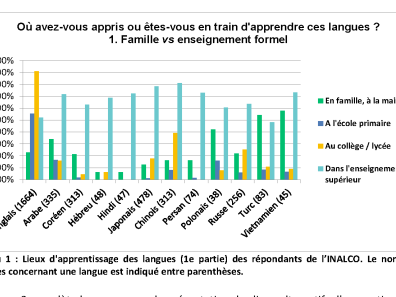
Table 2 completes the picture by presenting alternative places for language learning. Participants involved in learning English (39%), Hebrew (35%) and, to a lesser extent, Chinese (30%) indicate that they have taken part in study stays or internships abroad, while this type of learning modality remains rather modest in the case of Russian (18%) and Korean (17%).
Table 2 also reveals some interesting data on the place of self-taught learning. In fact, more than half of the respondents who studied Korean did so - probably prior to or concurrently with their enrolment at Inalco - as self-taught learners, while almost 48% of Japanese-speaking respondents also did so.
Learning via online platforms remains fairly modest, even in the case of Japanese (10%) and Chinese (5%), where a significant offer exists.
In addition to - or prior to - institutional university learning, there are also a few learning methods in so-called "community" schools (as the study puts it) or in a denominational context: the two languages concerned are Arabic and Hebrew, with 15% and 10% of respondents respectively. It should be noted that these figures are equivalent (for Arabic) or even higher than those of respondents indicating that they studied the language in the conventional education system.
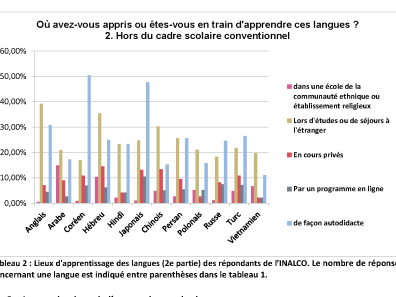
3. Motivations for language learning
The survey then turned to the reasons why respondents had chosen their language of learning at university. Inalco is unique in this survey in that it is an institution attended by language specialist students, unlike most respondents from other universities (including SOAS). As a result, the stakes involved in choosing a language here are undoubtedly higher than when learners choose a language as a mere option in their curriculum. It was therefore interesting to examine the reasons why these French students had opted for a particular language in their specialist pathway.
The respondents were given the opportunity to position themselves for several types of motivation, whether they were of a personal, family and identity-related nature, whether they were linked to an interest in culture, or whether they related to the development of professional or training skills.
The figures in the following Table 3 speak for themselves. The importance of interest in the cultures conveyed by the languages learned is very high, and is particularly evident for Japanese (almost 96% positive responses) and Korean (almost 92% positive responses), which seems to corroborate the hypothesis that one of the central elements of the attractiveness of Japanese and Korean in France is interest in Japanese and Korean cultures, particularly popular cultures. Similarly, responses relating to the essential place of culture exceed 80% among respondents learning Hebrew, Persian and Hindi, albeit on a much smaller statistical scale.
.
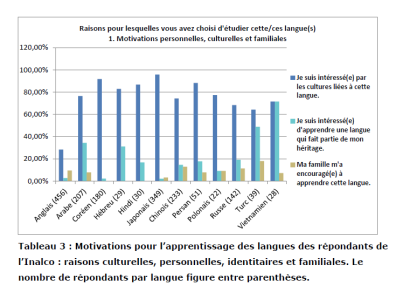
One of the problems faced by educationalists and sociolinguists is defining exactly what is meant by culture in language didactics. It is highly likely that differences of interpretation also emerge in this type of survey, as shown by the apparent link between appreciation of the culture carried by a language and its place in the respondents' origins. Here, we can clearly see that this link is virtually absent for Korean and Japanese, where barely more than 2% of respondents indicate that these languages are part of their heritage. Conversely - albeit on a smaller scale - many Arabic speakers (34%) and Hebrew speakers (31%) indicate that family heritage played a role in their choice of language. The figures in this area are particularly high for Turkish (49%) and Vietnamese, where just as many respondents tick the "culture" reason as the "origin" reason (71%). It should be noted that the role of family influence in the choice of language learning is not negligible in the case of Chinese speakers (13%) and Turkish speakers (18%).
These motivations, which psycholinguists define as integrative (i.e. the choice to appropriate a language and culture with which one wishes to identify in one way or another), are often accompanied by more instrumental reasons, reflecting an effort to learn a language with a view to accomplishing utilitarian tasks (taking exams, getting a job, getting a diploma, or simply interacting with speakers of that language). Table 4 presents some of these instrumental motivations.
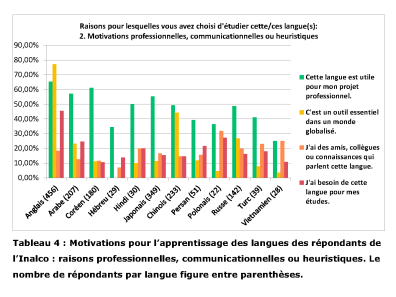
The advantage of leaving English out of Tables 3 and 4 is that we can clearly see the role of this language in the globalized academic and professional context in which these students position themselves. English, but also Chinese, languages of globalization, seem to offer participants a number of professional prospects (and even, in the shorter term, the possibility of student mobility).
We note here that Japanese and Korean speakers, while indicating cultural reasons for their choice of course, also tick the box of professional opportunities for Japanese (55%) and Korean (61%) languages. Students of Arabic (57%), Chinese (50%), Russian (48%) and Hindi (50%, out of a limited number of respondents) also perceive the professional potential opened up by learning these languages, while these professional prospects seem less relevant to learners of Hebrew (34%) and especially Vietnamese (25%) who responded to the survey.
4. Learning approaches
Expanding on the information in Table 2 above, the survey also looked at how respondents expressed their preference in terms of pedagogical approaches. Several options were proposed, presenting a variety of different types of approach: formal approaches (known as "captive", where the learner is in a learning situation in the classroom), informal approaches (where learning takes place in an immersive and minimally guided way), approaches where learning or self-learning takes place online, and finally mixed approaches, made up of elements of the previously described approaches.
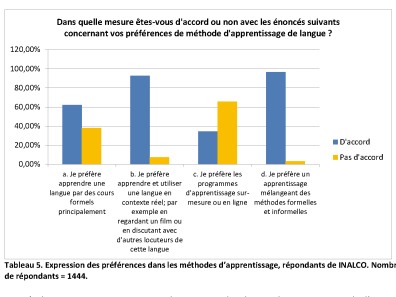
The results are clear and unsurprising: most Inalco participants favor approaches that mix formal and informal learning, in a context of real interaction (nearly 97% of respondents). These results show that, in addition to their preference for mixed approaches, respondents reject the idea of learning without real interaction or without activities that put the language being learned into action, and that a minority of them prefer online learning or self-learning programs. We also note that learning essentially through formal (i.e. captive) courses, while garnering 62% of positive opinions, is judged negatively by more than a third of French respondents (38%).
These questions can be compared here with some of the foreign partners who took part in the survey, as proposed in the following table 6.
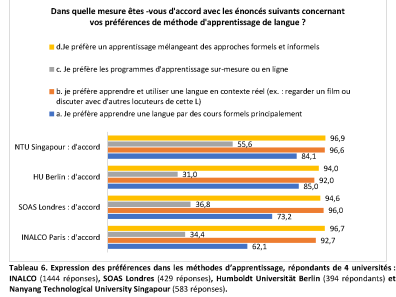
What emerges from this comparison is that in all four countries, respondents clearly favor mixed approaches offering both formal learning, in captive situations, and more informal learning, based on interaction with speakers. As we saw above, participants from Inalco are the least likely to indicate that they appreciate formal learning, while conversely, German and Singaporean students indicate, at 85% and 84% respectively, that they seem to appreciate this mode of learning. The majority of respondents from the three European universities were also negative about e-learning or self-study, while Singaporean students were mostly positive (almost 57%) about this learning modality.
It is not easy, on the basis of these data, to formulate explanatory hypotheses on possible differences in educational cultures, particularly between Europe and Asia, not least because the results of the Berlin survey sometimes give results close to European institutions (e.g. on online learning), sometimes close to the Singaporean profile (cf. opinions on formal learning).
5. Some conclusions and avenues
This final point calls for a few comments of a methodological nature. The portrait presented here has a panoramic virtue, i.e. it has the advantage and disadvantage of the survey and quantitative in general. The profile is based on a large number of respondents, and in the specific case of Inalco, we can count on a certain representativeness, given that the 1877 respondents constituted, in 2017-2017, some 22% of the total number of students enrolled at Inalco. Furthermore, as mentioned above, the data on age and gender were fairly similar to the overall number of students enrolled, and the first ten "oriental" languages (in the sense that this adjective is used at Inalco) appearing in the questionnaire corresponded in some detail to the institution's largest departments and sections.
However, this part of the study - briefly described in this article - is not sufficient if we really want to grasp the positions of today's students on the issues of language learning, circulation and commodification at university and in a society grappling with globalization. The investigation continued in 2018 and 2019 in a more ethnographic way, through interviews (conducted for the French part by Gilles Forlot and Shahzaman Haque) and through the observation and analysis of the discourses of the institution and its actors on the value and place of languages at the university as well as on the issues related to language learning.
It should be noted that a number of these issues are addressed and debated in Inalco's Didactics of Languages courses, in particular in an L3 DDL course on language biographies supervised by Céline Peigné, an M1 DDL seminar on the languages of France led by a group of colleagues from several Inalco departments, and an M2 DDL seminar on the place of languages in educational systems supervised by Gilles Forlot. Similarly, several DDL master's theses on these issues have been defended at Inalco in recent years.
Gilles Forlot
Professor of sociolinguistics and language didactics, Inalco